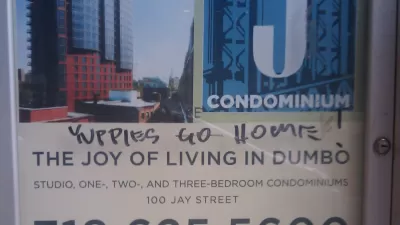As waves of gentrification sweep through the poor and middle class neighborhoods of New York City's outer boroughs, Stephen Smith argues that conservative, and outdated, zoning codes are to blame for the unequal balance between supply and demand.

Although some have taken issue with the extensive rezoning of New York that has taken place during the Bloomberg administration (since 2002, 40 percent of the city has been rezoned), for Smith those efforts have not gone far enough in replacing conservative zoning that keeps neighborhoods such as Williamsburg, Greenpoint and Bushwick "more or less frozen in 1961, when the city's zoning code restricted density and required parking in new construction."
According to Smith, the result of such controls is that as gentrification makes "significant inroads" in Brooklyn and Queens, "the housing that the poor are losing to the rich is not being replaced." And while such "conservative zoning" may be appropriate for "tree-lined blocks of Brooklyn Heights and Park Slope," for functional (misguided attempts to preserve manufacturing) and aesthetic (the houses are "some of the ugliest in the city") reasons northern Brooklyn should allow for more density.
"Zoned out of Williamsburg, Greenpoint and 'East Williamsburg,' gentrifiers have now reached the more densely populated black and Hispanic sections of Bushwick proper. Its poor and middle-class residents, who 20 years ago might have been able to afford apartments just a stop or two from Manhattan in Williamsburg, are now being displaced to neighborhoods like Canarsie, East New York and Jamaica, where they struggle with long commutes. It won't be too long until they're pushed so far from job centers in Manhattan that they leave the city entirely, contributing to the growing sense that New York is too expensive for ordinary people."
"If desirable neighborhoods don't start shouldering more of the burden of increased urban demand," concludes Smith, "American cities will soon end up like their counterparts in Europe, where everyone except the rich and the tourists are shunted off to the suburbs."
FULL STORY: Brooklyn's Affordability Crisis Is No Accident

Rethinking Redlining
For decades we have blamed 100-year-old maps for the patterns of spatial racial inequity that persist in American cities today. An esteemed researcher says: we’ve got it all wrong.

Planetizen Federal Action Tracker
A weekly monitor of how Trump’s orders and actions are impacting planners and planning in America.

Walmart Announces Nationwide EV Charging Network
The company plans to install electric car chargers at most of its stores by 2030.

New State Study Suggests Homelessness Far Undercounted in New Mexico
An analysis of hospital visit records provided a more accurate count than the annual point-in-time count used by most agencies.

Michigan Bills Would Stiffen Penalties for Deadly Crashes
Proposed state legislation would close a ‘legal gap’ that lets drivers who kill get away with few repercussions.

Report: Bus Ridership Back to 86 Percent of Pre-Covid Levels
Transit ridership around the country was up by 85 percent in all modes in 2024.
Urban Design for Planners 1: Software Tools
This six-course series explores essential urban design concepts using open source software and equips planners with the tools they need to participate fully in the urban design process.
Planning for Universal Design
Learn the tools for implementing Universal Design in planning regulations.
City of Moorpark
City of Tustin
City of Camden Redevelopment Agency
City of Astoria
Transportation Research & Education Center (TREC) at Portland State University
Regional Transportation Commission of Southern Nevada
Toledo-Lucas County Plan Commissions



























